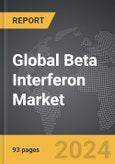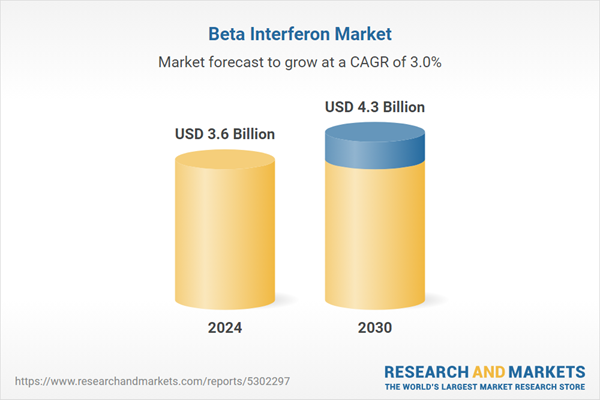The global market for Beta Interferon was valued at US$3.6 Billion in 2024 and is projected to reach US$4.3 Billion by 2030, growing at a CAGR of 3.0% over the analysis period 2024-2030. This comprehensive report provides an in-depth analysis of market trends, drivers, and forecasts, helping you make informed business decisions. The report includes the most recent global tariff developments and how they impact the Beta Interferon market.
Segments: Segment (Beta Interferon).
Geographic Regions/Countries: World; United States; Canada; Japan; China; Europe (France; Germany; Italy; United Kingdom; Spain; Russia; and Rest of Europe); Asia-Pacific (Australia; India; South Korea; and Rest of Asia-Pacific); Latin America (Argentina; Brazil; Mexico; and Rest of Latin America); Middle East (Iran; Israel; Saudi Arabia; United Arab Emirates; and Rest of Middle East); and Africa.
The analysts continuously track trade developments worldwide, drawing insights from leading global economists and over 200 industry and policy institutions, including think tanks, trade organizations, and national economic advisory bodies. This intelligence is integrated into forecasting models to provide timely, data-driven analysis of emerging risks and opportunities.
Global Beta Interferon Market - Key Trends and Drivers Summarized
What Makes Beta Interferon a Key Therapeutic Option for Multiple Sclerosis?
Beta interferon has become a cornerstone treatment in managing multiple sclerosis (MS), a chronic autoimmune condition that affects the central nervous system. Interferons are a group of signaling proteins produced naturally by the body in response to viral infections, and beta interferon, specifically, plays a critical role in modulating immune responses. As a therapeutic agent, beta interferon functions by reducing the inflammatory activity in the central nervous system, thereby slowing the progression of disease and decreasing the frequency of relapses. Its ability to alter the balance of pro-inflammatory and anti-inflammatory cytokines helps reduce the rate of demyelination - a hallmark of MS that leads to nerve damage and subsequent disability. Clinically, beta interferon is most effective in relapsing-remitting MS (RRMS), the most common form of the disease, and has shown significant efficacy in delaying the onset of physical disabilities and preventing new lesion formation visible on MRI scans. There are several formulations of beta interferon available, such as interferon beta-1a and interferon beta-1b, each with distinct dosing regimens and administration routes (intramuscular or subcutaneous injections), providing flexibility for personalized patient care.How Has Beta Interferon Evolved in the Context of Novel Multiple Sclerosis Therapies?
The therapeutic landscape for multiple sclerosis has undergone a significant transformation in recent years, with the introduction of new disease-modifying therapies (DMTs) that offer different mechanisms of action and improved efficacy profiles. Despite the influx of oral and infusion-based DMTs like fingolimod, ocrelizumab, and cladribine, beta interferon has maintained its relevance due to its well-established safety profile and long history of use. Its relatively mild side effect profile compared to newer immunosuppressants makes it a preferred option for patients who are newly diagnosed or have mild to moderate disease activity. Moreover, research into optimizing interferon delivery and enhancing patient adherence has led to the development of advanced formulations, such as pegylated interferon beta-1a, which requires less frequent administration - once every two weeks compared to the standard weekly or bi-weekly injections - without compromising efficacy. This advancement addresses a major limitation of traditional beta interferon therapy, which has been associated with poor adherence due to frequent injections and adverse effects. Additionally, combination therapies using beta interferon alongside other DMTs are being explored to maximize clinical outcomes by leveraging complementary mechanisms of action. For instance, pairing beta interferon with glatiramer acetate, an immunomodulatory agent, has shown promise in providing enhanced protection against relapses.What Are the Regulatory and Market Dynamics Influencing Beta Interferon Usage?
The use of beta interferon in clinical practice is heavily influenced by regulatory policies, clinical guidelines, and market trends. Regulatory agencies such as the U.S. Food and Drug Administration (FDA) and the European Medicines Agency (EMA) play a pivotal role in shaping the availability and adoption of beta interferon products through their rigorous evaluation of safety, efficacy, and manufacturing standards. Each formulation of beta interferon, including branded options like Avonex, Rebif, Betaseron, and Extavia, must undergo extensive clinical trials to demonstrate its therapeutic benefit and safety profile. These trials, often spanning several years, focus on parameters like relapse reduction, MRI lesion load, and disability progression, all of which are critical for securing regulatory approval. Once approved, beta interferon therapies are subject to post-market surveillance and risk management strategies to ensure ongoing patient safety. The pricing and reimbursement landscape also significantly impact the adoption and utilization of beta interferon. In many countries, cost-effectiveness analyses are conducted to justify coverage by national health systems or private insurers, particularly as more cost-intensive, high-efficacy therapies enter the market. Additionally, the availability of biosimilar versions of beta interferon, which offer comparable therapeutic outcomes at reduced costs, has begun to influence market dynamics by providing more affordable options for patients and healthcare systems. Clinical guidelines from authoritative bodies like the American Academy of Neurology (AAN) and the European Committee for Treatment and Research in Multiple Sclerosis (ECTRIMS) further shape usage patterns, recommending beta interferon as a first-line treatment for RRMS due to its robust safety data.What Are the Key Drivers Behind the Growth of the Beta Interferon Market?
The growth in the beta interferon market is driven by several critical factors, reflecting both the evolving nature of multiple sclerosis treatment and broader healthcare trends. One of the primary drivers is the increasing global prevalence of multiple sclerosis, particularly in developed regions like North America and Europe, where the disease burden is among the highest. The rising incidence, coupled with earlier diagnosis due to advancements in imaging technologies, has expanded the patient pool eligible for beta interferon therapy. Additionally, the relatively high safety profile of beta interferon compared to newer, more aggressive treatments has reinforced its position as a preferred first-line option, especially for patients with mild disease activity or those hesitant to start more intensive immunosuppressive therapies. The development of long-acting pegylated formulations has also contributed to market growth by enhancing patient compliance and reducing injection frequency, addressing one of the key limitations of traditional beta interferon products. Furthermore, strong support from clinical guidelines, which continue to endorse beta interferon for newly diagnosed and relapsing-remitting cases, sustains its widespread use despite the availability of newer agents. Another significant factor is the expansion of healthcare infrastructure and increased access to MS treatments in emerging markets. Lastly, ongoing research into combination therapies and the exploration of beta interferon’s role in other neurological conditions, such as secondary progressive MS, have sparked renewed interest and investment in this class of drugs. Together, these drivers underscore the continued relevance and growth potential of beta interferon in an increasingly crowded and competitive MS treatment landscape.Report Scope
The report analyzes the Beta Interferon market, presented in terms of units. The analysis covers the key segments and geographic regions outlined below.Segments: Segment (Beta Interferon).
Geographic Regions/Countries: World; United States; Canada; Japan; China; Europe (France; Germany; Italy; United Kingdom; Spain; Russia; and Rest of Europe); Asia-Pacific (Australia; India; South Korea; and Rest of Asia-Pacific); Latin America (Argentina; Brazil; Mexico; and Rest of Latin America); Middle East (Iran; Israel; Saudi Arabia; United Arab Emirates; and Rest of Middle East); and Africa.
Regional Analysis
Gain insights into the U.S. market, valued at $968.9 Million in 2024, and China, forecasted to grow at an impressive 4.5% CAGR to reach $854.0 Million by 2030. Discover growth trends in other key regions, including Japan, Canada, Germany, and the Asia-Pacific.Why You Should Buy This Report:
- Detailed Market Analysis: Access a thorough analysis of the Global Beta Interferon Market, covering all major geographic regions and market segments.
- Competitive Insights: Get an overview of the competitive landscape, including the market presence of major players across different geographies.
- Future Trends and Drivers: Understand the key trends and drivers shaping the future of the Global Beta Interferon Market.
- Actionable Insights: Benefit from actionable insights that can help you identify new revenue opportunities and make strategic business decisions.
Key Questions Answered:
- How is the Global Beta Interferon Market expected to evolve by 2030?
- What are the main drivers and restraints affecting the market?
- Which market segments will grow the most over the forecast period?
- How will market shares for different regions and segments change by 2030?
- Who are the leading players in the market, and what are their prospects?
Report Features:
- Comprehensive Market Data: Independent analysis of annual sales and market forecasts in US$ Million from 2024 to 2030.
- In-Depth Regional Analysis: Detailed insights into key markets, including the U.S., China, Japan, Canada, Europe, Asia-Pacific, Latin America, Middle East, and Africa.
- Company Profiles: Coverage of players such as Amoytop Biotech, Anke Bio, Changchun Institute of Biological Products, Hainan Unipul Pharmaceutical, Kawin and more.
- Complimentary Updates: Receive free report updates for one year to keep you informed of the latest market developments.
Some of the 42 companies featured in this Beta Interferon market report include:
- Amoytop Biotech
- Anke Bio
- Changchun Institute of Biological Products
- Hainan Unipul Pharmaceutical
- Kawin
- Kexing Biopharm
- Merck
- Roche
- Sinopharm
- SP (Brinny) Company
- Tri-Prime Gene
Tariff Impact Analysis: Key Insights for 2025
Global tariff negotiations across 180+ countries are reshaping supply chains, costs, and competitiveness. This report reflects the latest developments as of April 2025 and incorporates forward-looking insights into the market outlook.The analysts continuously track trade developments worldwide, drawing insights from leading global economists and over 200 industry and policy institutions, including think tanks, trade organizations, and national economic advisory bodies. This intelligence is integrated into forecasting models to provide timely, data-driven analysis of emerging risks and opportunities.
What’s Included in This Edition:
- Tariff-adjusted market forecasts by region and segment
- Analysis of cost and supply chain implications by sourcing and trade exposure
- Strategic insights into geographic shifts
Buyers receive a free July 2025 update with:
- Finalized tariff impacts and new trade agreement effects
- Updated projections reflecting global sourcing and cost shifts
- Expanded country-specific coverage across the industry
Table of Contents
I. METHODOLOGYII. EXECUTIVE SUMMARY2. FOCUS ON SELECT PLAYERSIII. MARKET ANALYSISIV. COMPETITION
1. MARKET OVERVIEW
3. MARKET TRENDS & DRIVERS
4. GLOBAL MARKET PERSPECTIVE
UNITED STATES
CANADA
JAPAN
CHINA
EUROPE
FRANCE
GERMANY
ITALY
UNITED KINGDOM
SPAIN
RUSSIA
REST OF EUROPE
ASIA-PACIFIC
AUSTRALIA
INDIA
SOUTH KOREA
REST OF ASIA-PACIFIC
LATIN AMERICA
ARGENTINA
BRAZIL
MEXICO
REST OF LATIN AMERICA
MIDDLE EAST
IRAN
ISRAEL
SAUDI ARABIA
UNITED ARAB EMIRATES
REST OF MIDDLE EAST
AFRICA
Companies Mentioned (Partial List)
A selection of companies mentioned in this report includes, but is not limited to:
- Amoytop Biotech
- Anke Bio
- Changchun Institute of Biological Products
- Hainan Unipul Pharmaceutical
- Kawin
- Kexing Biopharm
- Merck
- Roche
- Sinopharm
- SP (Brinny) Company
- Tri-Prime Gene
Table Information
| Report Attribute | Details |
|---|---|
| No. of Pages | 93 |
| Published | April 2025 |
| Forecast Period | 2024 - 2030 |
| Estimated Market Value ( USD | $ 3.6 Billion |
| Forecasted Market Value ( USD | $ 4.3 Billion |
| Compound Annual Growth Rate | 3.0% |
| Regions Covered | Global |









